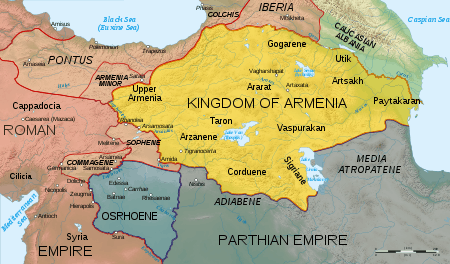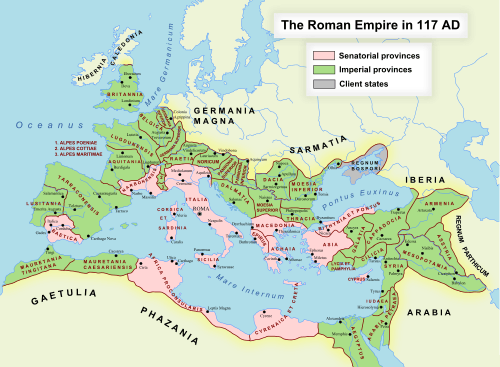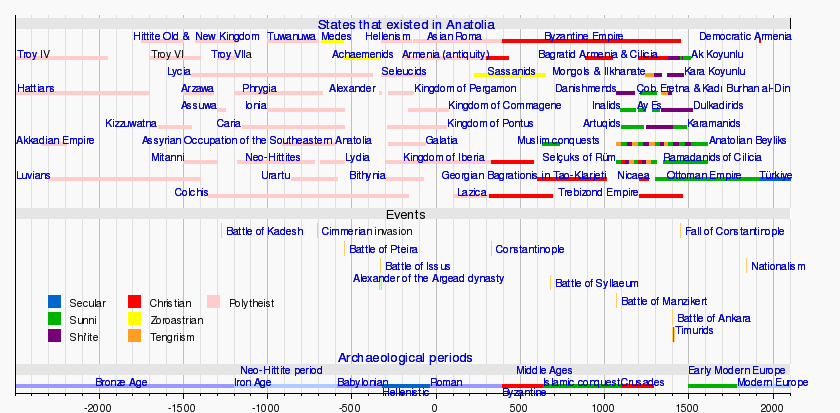Pontus
| Pontos (Πόντος) | |
|---|---|
| Ancient region of Anatolia | |
|
Traditional rural Pontic house | |
| Location | North-eastern Anatolia |
| Ethnic Groups | Pontic Greeks, Laz, Hemşin, Chepni, Turks |
| Historical capitals | Amasya, Neocaesarea, Sinope, Trabzon |
| Notable rulers | Mithradates Eupator |
 The modern definition of the Pontus: the area claimed for the "Republic of Pontus" after World War I, based on the extent of the six local Greek Orthodox bishoprics. | |
Pontus (/ˈpɒntəs/; Greek: Πόντος, "sea",[1]) is a historical Greek designation for a region on the southern coast of the Black Sea, located in modern-day northeastern Anatolia, Turkey. The name was applied to the coastal region and its mountainous hinterland (rising to the Pontic Alps in the east) in antiquity by the Greeks who colonized the area, and derived from the Greek name of the Black Sea: Πόντος Εύξεινος Pontos Euxeinos ("Hospitable Sea"[2]), or simply Pontos. Having originally no specific name, the region east of the river Halys was spoken of as the country εν Πόντοι en Pontôi, "on the [Euxeinos] Pontos", and hence acquired the name of Pontus, which is first found in Xenophon's Anabasis. The extent of the region varied through the ages, but generally it extended from the borders of Colchis (modern Georgia) until well into Paphlagonia in the west, with varying amounts of hinterland. Several states and provinces bearing the name of Pontus or variants thereof were established in the region in Hellenistic, Roman and Byzantine periods, culminating in the late Byzantine Empire of Trebizond. Pontus is sometimes considered as the home of the Amazons, with the name Amasia not only used for a city (Amasya) but for all of Pontus in Greek mythology.
History
Part of a series on the |
||||||||||||||||||||||||||||||||||||||||
|---|---|---|---|---|---|---|---|---|---|---|---|---|---|---|---|---|---|---|---|---|---|---|---|---|---|---|---|---|---|---|---|---|---|---|---|---|---|---|---|---|
| History of Turkey | ||||||||||||||||||||||||||||||||||||||||
 | ||||||||||||||||||||||||||||||||||||||||
|
||||||||||||||||||||||||||||||||||||||||
|
||||||||||||||||||||||||||||||||||||||||
|
||||||||||||||||||||||||||||||||||||||||
|
||||||||||||||||||||||||||||||||||||||||
|
||||||||||||||||||||||||||||||||||||||||
| Timeline | ||||||||||||||||||||||||||||||||||||||||
| Turkey portal | ||||||||||||||||||||||||||||||||||||||||
Pontus became important as a bastion of Byzantine Greek and Greek Orthodox civilization and attracted Greeks from all backgrounds (scholars, traders, mercenaries, refugees) from all over Anatolia and the southern Balkans, from the Classical and Hellenistic periods into the Byzantine and Ottoman. These Greeks of Pontus are generally referred to as Pontic Greeks, while eastern Pontic Greeks of Georgia and the former Russian Caucasus province of Kars Oblast (in present-day northeastern Turkey) are often called Caucasus Greeks.
Early inhabitants
Considering that the Anatolian Peninsula lies near to Sinai Peninsula, which is the isthmus across which various species of hominids have migrated out of Africa and into Asia, Pontus in particular has probably been inhabited by known and unknown tribes of various species and ethnicities throughout its history. The Caucasian Kartvelian languages, such as Laz, probably represent the tongues of the earliest-known inhabitants of the area. According to some researchers, one of the early Pontic tribes were called the Leucosyri.[3] Other names for the earliest-known, probably Caucasian, tribes that inhabited the area include the Moskhians, the Mares, the Makrones, the Mossynoikians, the Tibarenians,[4] the Tzans (Armenian: Chaniuk, probably the Laz),[5] and the Chaldians (Armenian: Khaghtik).[6] Given the early presence and possible origin of Indo-European languages in the Anatolian peninsula,[7] tribes speaking Indo-European languages such as Armenian, Hittite, or another Anatolian language may have inhabited the area more or less contemporaneously with tribes speaking Caucasian languages. Greeks, who spoke a different Indo-European language, began colonizing the area by sea at a later date and are the earliest inhabitants of the region from whom extensive written records survive.
Ancient Greek colonization
The first travels of Greek merchants and adventurers to the Pontian region occurred probably from around 1000 BC, whereas their settlements would become steady and solidified cities only by the 8th and 7th centuries BC as archaeological findings document. This fits in well with a foundation date of 731 BC as reported by Eusebius of Caesarea for Sinope, perhaps the most ancient of the Greek Colonies in what was later to be called Pontus.[8] The epical narratives related to the travels of Jason and the Argonauts to Colchis, the tales of Heracles' navigating the Black Sea and Odysseus' wanderings into the land of the Cimmerians, as well as the myth of Zeus constraining Prometheus to the Caucasus mountains as a punishment for his outwitting the Gods, can all be seen as reflections of early contacts between early Greek colonists and the local, probably Caucasian, peoples. The earliest known written description of Pontus, however, is that of Scylax of Korianda, who in the 7th century BC described Greek settlements in the area.[9]
Persian Empire expansion
By the 5th or 6th centuries BC, Pontus had become officially a part of the Achaemenid Empire, which probably meant that the local Greek colonies were paying tribute to the Persians.[10] When the Athenian commander Xenophon passed through Pontus around a century later in 401-400 BC, in fact, he found no Persians in Pontus.[10] Pontus came out from Persian domination when the Kingdom of Cappadocia separated from the Achaemenid Empire, taking Pontus with it as one of its provinces.[11] Subsequently, Pontus itself separated from the Kingdom of Cappadocia under Mithridates I Ktistes ("Ktistes", Κτίστης meaning "The Founder", Constructor in Greek) in 302 BC and became independent.[11] As the greater part of the kingdom he eventually established lay within the immense region of Cappadocia, which in early ages extended from the borders of Cilicia to the Euxine (Black Sea), the kingdom as a whole was at first called "Cappadocia towards the Pontus", but afterwards simply "Pontus", the name Cappadocia being henceforth restricted to the southern half of the region previously included under that title.
Kingdom of Pontus

The Kingdom of Pontus extended generally to the east of the Halys River. The Persian dynasty which was to found this kingdom had during the 4th century BC ruled the Greek city of Cius (or Kios) in Mysia, with its first known member being Ariobarzanes I of Cius and the last ruler based in the city being Mithridates II of Cius. Mithridates II's son, also called Mithridates, would become Mithridates I Ktistes of Pontus.
During the troubled period following the death of Alexander the Great, Mithridates Ktistes was for a time in the service of Antigonus, one of Alexander's successors, and successfully maneuvering in this unsettled time managed, shortly after 302 BC, to create the Kingdom of Pontus which would be ruled by his descendants mostly bearing the same name, until 64 BC. Thus, this Persian dynasty managed to survive and prosper in the Hellenistic world while the main Persian Empire had fallen.
This kingdom reached its greatest height under Mithridates VI or Mithridates Eupator, commonly called the Great, who for many years carried on war with the Romans. Under him, the realm of Pontus included not only Pontic Cappadocia but also the seaboard from the Bithynian frontier to Colchis, part of inland Paphlagonia, and Lesser Armenia. Despite ruling Lesser Armenia, King Mithridates VI was an ally of Armenian King Tigranes the Great, to whom he married his daughter Cleopatra.[12] Eventually, however, the Romans defeated both King Mithridates VI and his son-in-law, Armenian King Tigranes the Great, during the Mithridatic Wars, bringing Pontus under Roman rule.[13]
Roman province

With the subjection of this kingdom by Pompey in 64 BC, in which little changed in the structuring of life, neither for the oligarchies that controlled the cities nor for the common people in city or hinterland, the meaning of the name Pontus underwent a change. Part of the kingdom was now annexed to the Roman Empire, being united with Bithynia in a double province called Pontus and Bithynia: this part included only the seaboard between Heraclea (today Ereğli) and Amisus (Samsun), the ora Pontica. The larger part of Pontus, however, was included in the province of Galatia.[13]
Hereafter the simple name Pontus without qualification was regularly employed to denote the half of this dual province, especially by Romans and people speaking from the Roman point of view; it is so used almost always in the New Testament. The eastern half of the old kingdom was administered as a client kingdom together with Colchis. Its last king was Polemon II.
In AD 62, the country was constituted by Nero a Roman province. It was divided into the three districts: Pontus Galaticus in the west, bordering on Galatia; Pontus Polemoniacus in the centre, so called from its capital Polemonium; and Pontus Cappadocicus in the east, bordering on Cappadocia (Armenia Minor). Subsequently, the Roman Emperor Trajan moved Pontus into the province of Cappadocia itself in the early 2nd century AD.[13] In response to a Gothic raid on Trebizond in 457 AD, the Roman Emperor Diocletian decided to break up the area into smaller provinces under more localized administration.[5]

With the reorganization of the provincial system under Diocletian (about AD 295), the Pontic districts were divided up between three smaller, independent provinces within the Dioecesis Pontica:[5]
- Galatian Pontus, also called Diospontus, later renamed Helenopontus by Constantine the Great after his mother. It had its capital at Amisus, and included the cities of Sinope, Amasia, Andres, Ibora, and Zela as well.
- Pontus Polemoniacus, with its capital at Polemonium (also called Side), and including the cities of Neocaesarea, Argyroupolis, Comana, and Cerasus as well.
- Cappadocian Pontus, with its capital at Trebizond, and including the small ports of Athanae and Rhizaeon. This province extended all the way to Colchis.
Byzantine province and theme
The Byzantine Emperor Justinian further reorganized the area in 536:
- Pontus Polemoniacus was dissolved, with the western part (Polemonium and Neocaesarea) going to Helenopontus, Comana going to the new province of Armenia II, and the rest (Trebizond and Cerasus) joining the new province of Armenia I Magna with its capital at Justinianopolis.[5]
- Helenopontus gained Polemonium and Neocaesarea, and lost Zela to Armenia II. The provincial governor was relegated to the rank of moderator.
- Paphlagonia absorbed Honorias and was put under a praetor.
By the time of the early Byzantine Empire, Trebizond became a center of culture and scientific learning.[14] In the 7th century, an individual named Tychicus returned from Constantinople to establish a school of learning.[14] One of his students was the early Armenian scholar Anania of Shirak.[14]
Under the Byzantine Empire, the Pontus came under the Armeniac Theme, with the westernmost parts (Paphlagonia) belonging to the Bucellarian Theme. Progressively, these large early themes were divided into smaller ones, so that by the late 10th century, the Pontus was divided into the themes of Chaldia, which was governed by the Gabrades family,[14] and Koloneia. After the 8th century, the area experienced a period of prosperity, which was brought to an end only by the Seljuk conquest of Asia Minor in the 1070s and 1080s. Restored to the Byzantine Empire by Alexios I Komnenos, the area was governed by effectively semi-autonomous rulers, like the Gabras family of Trebizond.
Empire of Trebizond
Following Constantinople's loss of sovereignty to the Fourth Crusade in 1204, the Pontus retained independence as the Empire of Trebizond under the Komnenos dynasty. Through a combination of geographic remoteness and adroit diplomacy, this remnant managed to survive, until it was conquered by the Ottomans in 1461 after the Fall of Constantinople itself.[15] This political adroitness included becoming a vassal state at various times to both Georgia and to various inland Turkic rulers.[16] In addition, the Empire of Trebizond became a renowned center of culture under its ruling Komnenos dynasty.[16]
Ottoman vilayet
| Distribution of Nationalities in Trebizond Vilayet[17] | |||||||
| Source | Turks | Greeks | Armenians | Total | |||
|---|---|---|---|---|---|---|---|
| Official Ottoman Statistics, 1910 | 1,047,889 72.56% | 351,104 24.31% | 45,094 3.12% | 1,444,087 | |||
| Ecumenical Patriarchate Statistics, 1912 | 957,866 70.33% | 353,533 25.96% | 50,624 3.72% | 1,362,026 | |||
Under the subsequent Ottoman rule which began with the fall of Trebizond, particularly starting from the 17th century, some of the region's Pontic Greeks became Muslim through the Devşirme system. But at the same time some valleys inhabited by Greeks converted by own will, most notably those in the Of-valley; and large communities (around 25% of the population) of Christian Pontic Greeks remained throughout the area (including Trabezon and Kars in northeastern Turkey/the Russian Caucasus) until the 1920s, and in parts of Georgia and Armenia until the 1990s, preserving their own customs and dialect of Greek. One group of Islamicized Greeks were called the Kromli - They numbered between 12,000 and 15,000, were suspected of secretly having remained Christians, and lived in villages including Krom, Imera, Livadia, Prdi, Alitinos, Mokhora, and Ligosti.[18]
A remarkable change during the last period of the Ottoman Empire is the creation of "the Republic of Pontus" and the "Ponto-Armenian Federation" that did not take place as it was aimed to be and had as a result the genocide of at least 353,000 Pontian Greeks at the same time that the Armenian genocide took place. The number is based at facts from the relatives of murdered persons, Red Cross, French, and American reports from that period.
Present
The Black Sea Region (Turkish: Karadeniz Bölgesi) is one of Turkey's seven census-defined geographical regions.


Religion
Mentioned thrice in the New Testament, inhabitants of Pontus were some of the very first converts to Christianity. Acts 2:9 mentions them present during the Day of Pentecost. Acts 18:2 mentions a Jewish couple from Pontus that had converted to Christianity. And 1 Peter 1:1, Peter the Apostle addresses the Pontians in his letter as the "elect" and "chosen ones". As early as the First Council of Nicea, Trebizond had its own bishop.[6] Subsequently, the Bishop of Trebizond was subordinated to the Metropolitan Bishop of Poti.[6] Then during the 9th century, Trebizond itself became the seat of the Metropolitan Bishop of Lazica.[6]
Episcopal sees
Ancient episcopal sees of the Roman province of Helenopontus listed in the Annuario Pontificio as titular sees :[19]
Ancient episcopal sees of the Roman province of Pontus Polemoniacus listed in the Annuario Pontificio as titular sees:[19]
- Cerasus
- Comana Pontica
- Polemonium
- Rhizaeum
- Trapezus
Famous Pontians
- Strabo, a Greek historian, geographer, and philosopher.
- Evagrius Ponticus, a Greek theologian/monk of the 4th century
- Chrysanthos Theodoridis Singer
- A.I. Bezzerides, an American novelist and screenwriter. Famous for writing Humphrey Bogart movies, and co-creator of the TV series The Big Valley. Born in Samsun.
- Mike Lazaridis,CEO of Research in Motion and creator of BlackBerry phones.
See also
- Republic of Pontus
- Greek genocide
- Pontic Greek
- Caucasus Greeks
- Amaseia, Ancient capital of Pontus
Sources
- Bryer, Anthony A. M. (1980), The Empire of Trebizond and the Pontos, London: Variorum Reprints, ISBN 0-86078-062-7
- Ramsay MacMullen, 2000. Romanization in the Time of Augustus (Yale University Press)
![]() This article incorporates text from a publication now in the public domain: Chisholm, Hugh, ed. (1911). Encyclopædia Britannica (11th ed.). Cambridge University Press.
This article incorporates text from a publication now in the public domain: Chisholm, Hugh, ed. (1911). Encyclopædia Britannica (11th ed.). Cambridge University Press.
Footnotes
- ↑ πόντος, Henry George Liddell, Robert Scott, A Greek-English Lexicon, on Perseus
- ↑ Εὔξεινος, William J. Slater, Lexicon to Pindar, on Perseus
- ↑ Meyer, Geschichte d. Königr. Pontos (Leipzig,1879)
- ↑ Hewsen, 40-41
- ↑ 5.0 5.1 5.2 5.3 Hewsen, 43
- ↑ 6.0 6.1 6.2 6.3 Hewsen, 46
- ↑ Remco Bouckaert; Philippe Lemey; Michael Dunn; Simon J. Greenhill; Alexander V. Alekseyenko; Alexei J. Drummond; Russell D. Gray; Marc A. Suchard; Quentin D. Atkinson (24 August 2012). "Mapping the Origins and Expansion of the Indo-European Language Family". Science 337 (6097): 957–960. doi:10.1126/science.1219669. PMC 4112997. PMID 22923579.
- ↑ Hewsen, 39-40
- ↑ Hewsen, 39
- ↑ 10.0 10.1 Hewsen, 40
- ↑ 11.0 11.1 Hewsen, 41
- ↑ Hewsen, 41-42
- ↑ 13.0 13.1 13.2 Hewsen, Robert H. (2009). "Armenians on the Black Sea: The Province of Trebizond". In Richard G. Hovannisian. Armenian Pontus: The Trebizond-Black Sea Communities. Costa Mesa, CA: Mazda Publishers, Inc. pp. 42, 37–66. ISBN 1-56859-155-1.
- ↑ 14.0 14.1 14.2 14.3 Hewsen, 47
- ↑ Hewsen, 49
- ↑ 16.0 16.1 Hewsen, 48
- ↑ Pentzopoulos, Dimitri (2002). The Balkan exchange of minorities and its impact on Greece. C. Hurst & Co. Publishers. pp. 29–30. ISBN 978-1-85065-702-6.
- ↑ Hewsen, 54
- ↑ 19.0 19.1 Annuario Pontificio 2013 (Libreria Editrice Vaticana 2013 ISBN 978-88-209-9070-1), "Sedi titolari", pp. 819-1013
External links
| Wikimedia Commons has media related to Pontus. |
Coordinates: 40°36′N 38°00′E / 40.6°N 38.0°E
| ||||||
| ||||||||
| ||||||||||||||||||||||||||||||||||||||||||||||||||||||||||||||||||||||||||
| ||||||||||||||||||||||||||||||||||||||||||||||||||||||||||||||||||||||||||||||||||||||||||||||||||||||||||||||||||||||||||||||||||||||||||||||||||
| ||||||


